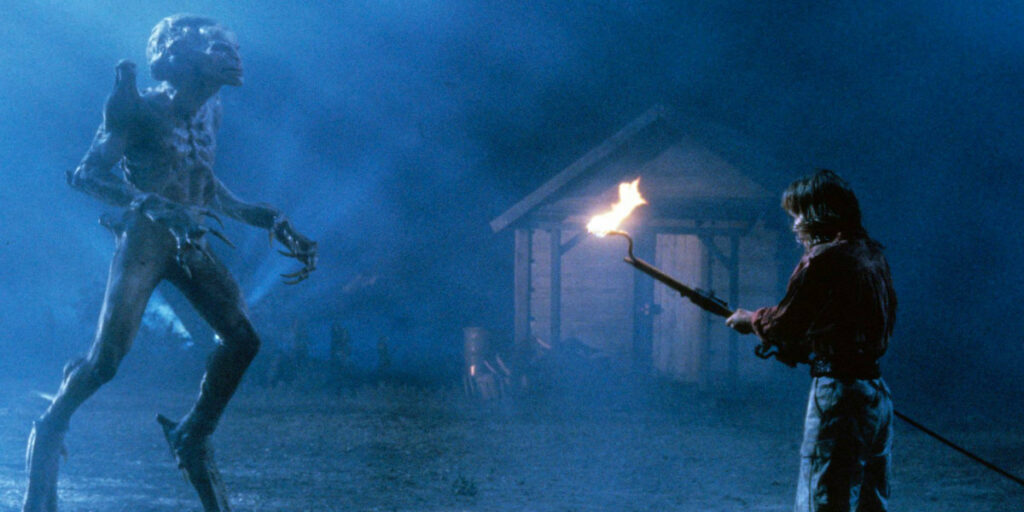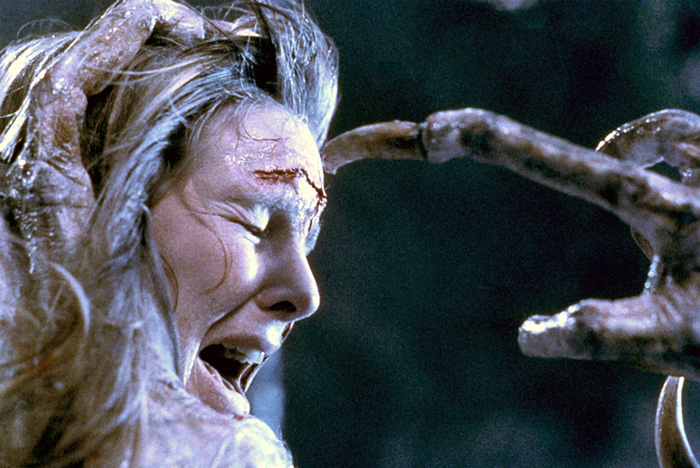‘Pumpkinhead’: The End of an Era

In cinema, very rarely can you pinpoint the end of an era. Even more rarely can you pinpoint it down to one specific film. Such is the case with Pumpkinhead. No, that is not a euphemism, but a 1988 creature feature directed by legendary special effects maestro Stan Winston. Loosely based on the Ed Justin poem of the same name, Pumpkinhead centers around a farmer, played by Lance Henriksen, who resurrects the eponymous demon to avenge the death of his son.
While no masterpiece, Pumpkinhead stands as a well-made monster movie with gripping performances, heavy atmosphere, and masterful creature effects. It’s a highly recommended film for any fan of the horror genre. But that’s not why I wanted to talk about this film, as much affection that I have for it. Instead, I wanted to focus on Pumpkinhead’s place among the history of horror films, monster movies in particular, and how it very much represents the end of an era.
Related: A ‘Pumpkinhead’ Remake Is Now In the Works
Pumpkinhead is the last notable monster movie to carry on the tradition established by the classic Universal Monsters. Specifically, how the central monster serves as an extenuation of human tragedy. The classic monsters are not only icons of the silver screen, but metaphors, literary vehicles to explore and dissect humanity’s most egregious and inherent failings.
Characters such as The Frankenstein Monster, the Phantom of the Opera, and the Hunchback of Notre Dame were more shaped by their abuse at the hands of society’s intolerance than they were by any deformity. None of these characters were created to be monsters. But it was mankind’s narrow and limited worldview that made them such perversions of humanity. Then there are characters such as Dracula, a monster who represents the evils of greed, debauchery, and seduction. He’s a creature who is forced to feed off the blood of the living to preserve his own foul existence.
Lastly, there’s The Wolfman. He’s an ordinary human being who’s not a monster through any fault of his own. But the beast which lays within him is a demon that can’t be kept at bay and ultimately consumes him. A victim to an irreversible curse, The Wolfman’s only hope of peace is to take his own life. This sharply parallels those suffering from mental illnesses who often turn to self-harm and even suicide. Even King Kong and Godzilla, the most fantastical horror icons of the modern age, serve as metaphors for the effects of colonialism and nuclear power.
Related: Exclusive Interview: Peter Block Talks THE SHED, FRIGHT NIGHT & Confirms Big News Coming on PUMPKINHEAD Remake

However, around the 1950s, audiences would begin to shift away from the classic, archetypal movie monster. After the all-too-real horrors brought on by WW2 and the Holocaust, audiences would favor a more pure form of escapism. This resulted in the B-movie era of monster films, such as The Blob and Invasion of the Saucer Men. These films offered much in the way of entertainment value, but little in the way of subtext.
Horror films would shift even farther away from the classic movie monster with the emergence of the slasher genre. The “monsters” which originated from this movement were often human in presentation but monstrous in characterization, almost an inverse of the classic monster. With icons such as Michael Myers and Freddy Krueger, the slasher villain typically didn’t have a backstory and/or motivation. This was done to preserve the “boogeyman” mystique that defined the so-called movie monster of that era.
That’s not to say that modern horror lacks subtext. John Carpenter’s Halloween touches on themes of suburban anxiety, after all. But, the antagonists are characterized with less dimension and utilized to instigate conflict, as opposed to centering on it. The mute and emotionless Michael Myers is a blank slate, an unpainted canvass for audiences to imprint and project their own fears. And after the legendary success of Halloween, that became something of a gold standard.
Related: ‘Wolfman’: Derek Cianfrance Will Direct Ryan Gosling in Universal Monster Movie
Even Jason Voorhees, the closest thing to a traditional and classic movie monster the slasher genre had to offer, has a tragic backstory that served as an explanation for his behavior rather than an examination. The franchise glazed over the character’s pathos in favor of, once again”, the “boogeyman mystique.”
But when slasher films were dominating the horror genre, along came Pumpkinhead. It stood as a proud, loving tribute to the classic movie monster for a new generation. Not only because Pumpkinhead is a monster with a name that is simultaneously both silly and awesome, a feat the Universal movies perfected, but also because the creature itself is openly declared to be a metaphor, this time dealing with themes of vengeance and retribution.
Not only that, but Pumpkinhead is a direct product of moral failure, a constant theme throughout the classic movie monster. The monster challenges our protagonist not only physically, but psychologically as well. Just like Frankenstein confronting his own creation, Ed Harley must battle a monster of his own making. In the most literal sense possible, Ed Harley must confront his personal demons more than anything.

Related: RUMOR: Jordan Peele & Will Smith Universal Monster Movie In The Works
While Pumpkinhead enjoyed moderate success upon initial release and has endured an ever-expanding cult following, it’s also clear that it didn’t revitalize the classic movie monster. Instead, it served as the last, dying breath for this subgenre. Aside from subsequent adaptations and remakes of these classic properties, such as Francis Ford Coppola’s – I’m sorry – “Bram Stoker’s” Dracula, horror movies have almost completely abandoned the classic movie monster.
Even in critically-acclaimed monster movies of recent years, such as A Quiet Place or Cloverfield, the monsters only serve as non-descript creatures that serve to instigate the central conflict, making them more of a plot device than anything.
But Pumpkinhead showed modern audiences that monsters could be central to the conflict itself; they didn’t have to be such a peripheral element to the narrative. Movie monsters have been proven to be excellent means of dealing with a wide range of sociopolitical topics. This makes the fact that they’re so grossly underutilized in a thematic sense at least, all the more disappointing.
It’s difficult to say if the classic movie monster will ever make a return to modern cinema. Perhaps modern audiences have grown so accustomed to this new wave of movie monsters that they no longer find the classic, archetypal monster to be effective. It’s certainly true that audiences have furiously rejected many attempts to “humanize” the new horror icons, such as Rob Zombie’s Halloween. A soul can be a liability to the modern “movie monster.”
Regardless of what happens to this subgenre, we have Pumpkinhead to thank for reminding us that not only can monster movies kick ass, but they can also speak to us on a deeper, more personal level that doesn’t get acknowledged enough.
Categorized:Editorials News

